Winton Weyapuk
The following is a transcription of a conversation between Christopher Hudacek and Winton Weyapuk. Mr. Ethan Forbes was also part of the conversation, but only had limited input. The conversation occurred during the summer of 2002 and was conducted via telephone.
Chris: When were you born?
Winton: I was born on December 9, 1950.
Chris: How many people live in your village?
Winton: About 150 people come and go.
Chris: What do you do for entertainment?
Winton: Walking on the beach, hiking on the mountain, and native dances for different occasions. I watch some television sometimes or watch movies.
Chris: Do you have any pets?
Winton: No. I used to have a dog but it died a few years ago.
Chris: Are there ever any accidents in Wales?
Winton: Not very often, they1re pretty rare. Some people have accidents with their ATV1s
(4-wheeelers). Sometimes they crash or lose control, some times very rarely; people get into accidents when they1re hunting.
Chris: What if you need a doctor?
Winton: We send people to a hospital in Nome, but there are 2 or 3 health aides here that
treat people with minor injuries. (Nome is 111 air miles away)
Chris: Where are your ancestors from?
Winton: My parents were from here in Wales, but my mom was born in a village 15 miles south from here. My grandfather was from Wales, my grandmother was from the Russian side. (which is 5 miles across the Bering Strait.
Chris: Do you speak more than one language?
Winton: English and Inupiaq, Eskimo, some Russian but not much.
(Extra Winton) My family traveled a lot and went camping.
Chris: Is your family still in Wales?
Winton: One brother, nephews, and nieces. I1ve got two sisters living in Nome. My parents are dead.
Chris: When did you and your children learn to hunt?
Winton: I learned to hunt at about 11 or 12 years old. I would hunt with my father and the
crew my father was with. We hunted walrus.
(Extra, added info from Ethan Forbes) A skin boat is called an umiak. The inner shell is made from wood and the outer part was made from walrus skin.
Chris: Are there any special rituals, celebrations, or dances and if so, how do the kids learn them?
Winton: Every year we hold a native dance festival. We invite people from different
villages, (it lasts 3 days) to bring their native dances. We also hold dances when one of the whaling crews gets a whale. Also when our family and friends come home and bring their dance groups, we dance with them.
Chris: Do you make crafts?
Winton: Some, not a whole lot. Sometimes I make jewelry, earrings, rings, bracelets out of walrus. I want to learn how to make little bone figures or sometimes I use whale baleen.
Chris: When you hunt the whales, how far out do you go to get them?
Winton: Sometimes only about 3 miles, sometimes we have to go a little bit further. About 15 to 20 miles is the limit.
Chris: About how long does it take?
Winton: It depends on the weather, sometimes we are out hunting for 16 hours to 20 hours.
Sometimes the weather changes quickly and we are back within an hour. The
weather here can change fast from a nice day to a stormy day. We have to watch the weather closely to keep safe.
Ethan: Does it take 16 hours to bring the whale in?
Winton: It depends on the distance. It can take as little as a half hour to 5 or 6 hours if it is 3 miles away. The longest one I1ve seen was 24 hours long. We tow it with an aluminum casket and our motor. Usually when one of the crews kills a whale, one of the crews nearby help tow.
Ethan: Is it dangerous because they are so heavy?
Winton: Not really. It can be dangerous if there is a strong ocean current that is
pulling the whale.
Ethan: What kind of whale is it usually?
Winton: Usually a bowhead. We also hunt for beluga whale. They1re smaller. They1re about 16 feet, about the size of a dolphin. A bowhead is about 60 feet. We try to catch the smaller ones. They1re easier to kill. 28 to 32 feet is big enough. Baby whales taste tenderer. (as a rule for whales 1 foot is equal to 1 ton in weight)
Chris: How many people help catch the whale?
Winton: There are usually about 5 people in a whaling crew. It1s always men, except
sometimes a wife or a sister.
Chris: How much meat do you get from a whale?
Winton: A lot. Whales weigh about one ton per square foot. It1s enough to feed our village and family.
Chris: What part of the whale do you use?
Winton: Just about every part. We eat all the meat and muktuk. We save the baleen for crafts. We also save the bone for crafts.
Chris: What other kinds of food do you eat?
Winton: We eat walrus and seal; sometimes we might get a polar bear. We eat fish. In the fall we gather and eat shellfish. We pick greens off the mountain. We also get berries in the fall. We eat moose, reindeer, musk ox, ducks, and geese.
Ethan: Do you ever help with the reindeer herd?
Winton: Sometimes, I don1t do it as often as I used to when I was younger. I used to wrestle reindeer or wash the gate of the pen. They1d send the reindeer to a shutes and I1d open and close the gate.
Ethan: How old are you right now?
Winton: 52.
Ethan: Do the kids play sports?
Winton: The play basketball when school starts. We used to play Eskimo baseball. We also played something called manamuna, it1s like capture the flag except you have to run around their oval and back to yours to score a point. If the other team tags your, than you still have to go to jail.
Ethan: Do you go ice fishing?
Winton: Yes, in January we catch small mouth, in February we cut holes in the ice and use a spear to spear flounder.
Ethan: How thick is the ice?
Winton: 3 to 4 feet to get the hole, we use an auger or an ice chipper. It takes about 2 or 3 hours with an ice chipper.
Ethan: Do they have any colleges where you live?
Winton: No.

Winton works for the IRA office in Wales. He was a whaling captain.
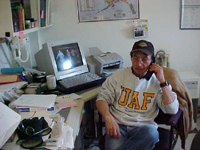
Winton is at his desk at the IRA office.

Here is an umiak or skin boat. This was the traditional boat for hunting whales. Today they may still use it, but also use modern boats. The umiak is covered with 3-4 walrus skins.
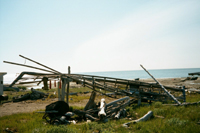
Here is a shell of an umiak. It takes days for the walrus hide to be dryed and then stretched. It is ten fitted over the frame. They always have more hide available if they need to patch the umiak.
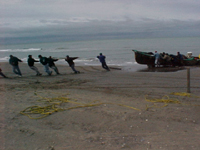
These men are pulling in the umiak. The currents in the Bering Strait are very strong.
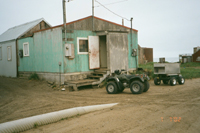
Main St.
IRA office

Here is the other government building, the Dome.
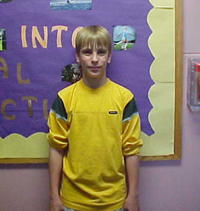
Chris did a wonderful job of interviewing Winton.
|
